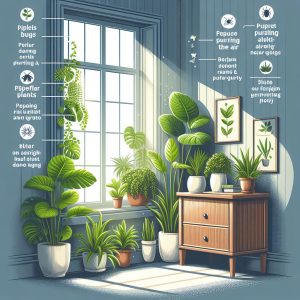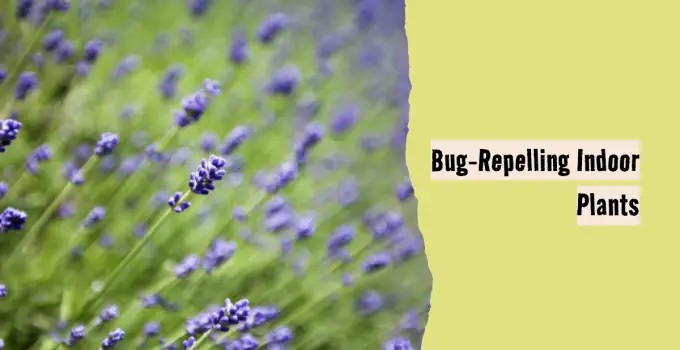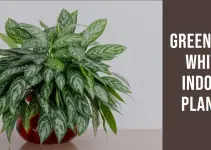MARBERO Portable Power Station 88Wh Camping Lithium Battery Solar Generator Fast Charging with AC Outlet 120W Peak Power Bank(Solar Panel Optional) for Home Backup Outdoor Emergency RV Van Hunting
18% OffGarden Hose 100 ft, 2025 Upgarded Flexible Water Hose 100ft With 10-Pattern Spray Nozzle, Kink-Free, Lightweight, Durable, Leak-Proof Solid Brass Fittings (Black & Blue)
20% OffIndoor Plants That Repel Bugs and Insects
Houseplants indoors provide many benefits – they purify the air, add warmth, and brighten living spaces. However, some indoor plants also have the added advantage of naturally repelling common household bugs and insects. Using specific bug-repelling plants is an easy, natural way to discourage pests without having to use harmful chemicals.
Why Use Indoor Plants to Repel Bugs?
There are several benefits to using indoor plants as a natural deterrent against bugs:
- Avoid toxic chemicals – Insect-repellent sprays and foggers contain harmful ingredients. Repelling bugs with plants avoids introducing toxins inside your home.
- Safe for people and pets – The compounds that plants use to repel bugs are non-toxic for humans and pets. They create an environment that bugs don’t like, but that is harmless for people.
- Effective control – Certain plants contain oils, compounds, and scents that bugs find unpleasant or confusing. Using these plants makes indoor spaces far less inviting for a wide array of crawling and flying pests.
- Always working – Unlike spraying a repellent, you don’t have to reapply a plant’s defenses. As long as the plant is healthy, it will constantly emit bug-confusing odors.
- Natural decor – Rather than use ugly traps or tacky deterrents, plants blend into indoor spaces as decorative additions. A home filled with plants has a pleasant, natural feel.
Using plants to repel bugs means you avoid toxic chemicals while benefitting from natural pest control. Plants that keep away insects can be used as part of an integrated pest management plan for a home without pests.
Best Plants for Repelling Common Household Bugs
Many plants have properties that repel or deter crawling insects, flying insects, and even rodents from indoor spaces. Using a strategic combination of these plants allows you to combat a broad spectrum of household pests without nasty chemicals.
Insects That Are Repelled
Certain plants target specific common indoor bugs:
- Ants – Strongly repelled by mint, tansy, pennyroyal, garlic, and lemongrass
- Flies – Greatly deterred by basil, mint, bay leaf, lemongrass, lavender, eucalyptus
- Roaches – Confused and avoided by bay leaves, cucumber, marigolds, catnip
- Spiders – Repelled by eucalyptus, lemongrass, lavender, peppermint
- Beetles – Deterred by mint, cedar, rue, and bay leaves
- Bed bugs – Repelled by lavender, thyme, neem oil plants
- Bees and wasps – Confused by lavender, mint, marigolds, eucalyptus
- Mosquitoes – Repelled by lemon balm, catnip, marigolds, basil
Most Effective Indoor Plants for Repelling Bugs
The plants shown in Table 1 below have natural compounds, scents, and oils that effectively repel a wide array of bugs that commonly invade homes:
Table 1. Top Plants That Repel Indoor Bugs and Insects
| Plant | Effective Against | Key Properties |
|---|---|---|
| Lavender | Ants, flies, moths, spiders | Strong scent confuses bugs |
| Mint | Ants, flies, beetles, spiders, mosquitoes | Scent and oils deter bugs |
| Basil | Flies, mosquitoes, aphids | Repelling scent, antioxidant oils |
| Marigolds | Roaches, mosquitoes, aphids, nematodes | Strong scent deters bugs |
| Catnip | Roaches, spiders, mosquitoes | Nepetalactone oil repels insects |
| Chives | Aphids, spider mites, ants | Sulfur compounds deter pests |
| Lemon balm | Mosquitoes | Powerful lemon scent |
| Eucalyptus | Flies, ants, bees, wasps | Bug confusing/repelling oils |
| Garlic | Ants, spiders, aphids | Strong sulfur scent |
| Peppermint | Spiders, ants, beetles | Menthol scent repels bugs |
| Bay laurel | Roaches, flies, ants beetles | Insects dislike fragrance |
Where to Place Bug-Repelling Plants

Strategically placing plants that repel specific insects allows you to take advantage of their bug-confusing properties.
- Entryways – Place potted plants like lavender, mint, basil, or chives near exterior doors. This helps discourage initial entry by flies, ants, mosquitoes, and spiders.
- Kitchen windows – Marigolds, basil, mint, or garlic plants on kitchen window sills help deter flies and ants from finding ways inside.
- Bathrooms – Spider-repelling plants like peppermint, eucalyptus, or lavender prevent spiders from taking up residence.
- Bedrooms – Lavender, catnip, and lemon balm nearby help repel mosquitoes, spiders, and bed bugs.
- Windows and air vents – Screens don’t always keep tiny insects out. Placing lemon balm, eucalyptus, mint, or marigolds near vents/windows prevents access points.
- Living rooms – Bay laurel, lavender, and lemongrass in living rooms help repel roaches, ants, and beetles.
Pay attention to problem areas and place appropriate repellent plants strategically around your home. Some plants also make suitable additions to window boxes or potted outdoor plants during warmer months.
Growing Tips for Maximum Bug Protection
Growing healthy, vibrant plants is key to unleashing their full bug-busting potential. Here are some tips:
- Choose young starts from reputable garden centers. Inspect roots and leaves closely for any bugs or diseases. Pest issues are hardest to remedy when plants are fully mature.
- Select hearty plants suited for indoor growing. More delicate species may not thrive as well indoors. Refer to plant species profiles to understand conditions and care.
- Use clean containers and fresh potting mix. Sterilize used pots before reuse.
- Find optimal lighting for each species and change location accordingly as seasons shift.
- Water appropriately – droopy leaves mean too little water while yellowing leaves indicate overwatering.
- Apply general-purpose liquid fertilizer monthly according to label directions to nurture plants.
- Prune plants for better growth and shape if needed. For some plants like mint, trimming creates a denser, bushier plant.
- Turn pots periodically and pinch/wipe dust from leaves to maximize exposure to air and light.
- Look for common issues like powdery mildew, spider mites, or fungus. Treat with organic sprays made for each condition.
- Replace aging plants with young starts to maintain vigorous bug repellency. Older plants lose efficacy.
Caring properly for plants enables them to grow strongly and produce bug-confusing/repelling oils and compounds. Replacing older plants ensures you always have the most effective versions.
Frequently Asked Questions About Bug-Repelling Plants
How quickly will I see fewer bugs inside after adding plants?
It may take a few weeks after placing plants until you notice a reduction in indoor bugs getting inside. The plants need time to grow strong and emit their helpful compounds and scents at full strength. Combining plants that target different bugs speeds up the repellent effects.
Where should I place the plants – on the floor or elevated?
Elevating plants tends to increase their bug-fighting reach. Try placing them on plant stands, on side tables, window sills, counters, or shelf ledges. Choose your location based on entry points and problem areas bugs frequent. Place plants directly blocking common problem entryways like doors or air vents.
How often must I replace aging bug-repelling plants?
Most plants maintain their efficacy for one to three growing seasons. Mint, lemongrass, and bay laurel may last a full three seasons while basil, marigolds, and chives may need replacing every one or two seasons. If properly cared for, most take about three years to lose potency. Know each plant’s lifespan and replace it on schedule.
How many plants will I need for adequate bug protection?
The number needed depends on how problematic the bugs are, the size of the space, and the number/size of plants used. For example, two medium mint plants may suffice for an apartment kitchen. But a large house with spider issues may need five or more small spider-repelling plants placed in key areas for adequate control. Observe issues and adjust the number and placement as required.
What if I have both flying and crawling bug problems?
Use a combination of plants selected for repelling the specific bugs invading your home. If you have issues with both ants coming inside and fruit flies, use ant-repelling plants like mint by doorways but place basil and marigolds by the kitchen and bathrooms for the flies. Target all categories of pests inside for maximum impact.
Using plants to repel household bugs is an affordable, natural method that anyone can implement at home. Take advantage of plants’ built-in pest control powers to prevent ant, spider, cockroach, and fly problems without using a single chemical!




























